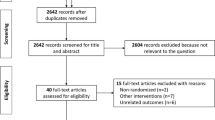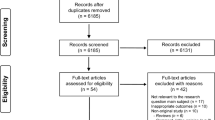Abstract
Study design: Literature review to evaluate the practical techniques used for intermittent catheterization (IC) and intermittent self-catheterization (ISC).
Objectives: To ascertain the requirements for proper IC and ISC. To evaluate if a best technique exists.
Methods: Relevant articles on the subject are reviewed.
Conclusion: There is a wide variety of materials and techniques applied for IC and ISC. This does not seem to change the practical outcome much if the basic principles are used: good education and training, clean and atraumatic technique, good patient compliance in the long-term. There is neither one best technique nor one best material for IC. Both depend greatly on the patient's individual anatomic, social and economic state.
Similar content being viewed by others
Log in or create a free account to read this content
Gain free access to this article, as well as selected content from this journal and more on nature.com
or
References
Guttmann L, Frankel H . The value of intermittent catheterization in the early management of traumatic paraplegia and tetraplegia Paraplegia 1966 4: 63–83
Lapides J, Diokno A, Silber S, Lowe B . Clean intermittent self catheterization in the treatment or urinary tract disease J Urol 1972 107: 458–461
Maynard FM, Diokno A . Clean intermittent catheterization for spinal cord injured patients J Urol 1982 128: 477–480
Diokno AC, Sonda LP, Hollander JB, Lapides J . Fate of patients started on clean intermittent self-catheterization 10 years ago J Urol 1983 129: 1120–1122
Sutton G, Shah S, Hill V . Clean intermittent self-catheterization for quadriplegic patients-a five year follow up Paraplegia 1991 29: 542–549
Madersbacher H et al. Conservative management in the neuropathic patient In: Abrams P, Khoury S, Wein A (eds) Incontinence Health Publications Ltd 1999 pp. 775–812
Wu Y, Hamilton BB, Boyink MA, Nanninga JB . Re-usable catheter for longterm intermittent catheterization Arch Physic Med Rehab 1981 62: 39–42
Bennett CJ et al. The effect of urethral introducer tip catheters on the incidence of urinary tract infection outcomes in spinal cord injured patients J Urol 1997 158: 519–521
Lundgren J et al. The importance of osmolality for intermittent catheterization of the urethra Spinal Cord 2000 38: 45–50
Waller L, Telander M, Sullivan L . The importance of osmolality in hydrophilic urethral catheters a crossover study Spinal Cord 1998 36: 368–369
Biering-Sorensen F, Nielsen K, Hansen HV . Urethral epithelial cells on the surface on hydrophilic catheters after intermittent catheterization: cross-over study with two catheters Spinal Cord 1999 37: 299–300
Wyndaele JJ et al. Evaluation of the use of Urocath-Gel catheters for intermittent self-catheterization by male patients using conventional catheters for a long time Spinal Cord 2000 38: 97–99
Hedlund H et al. Hydrophilic versus non-coated catheters for intermittent catheterization Scand J Urol Nephrol 2001 35: 49–53
Burgdörfer H et al. Manual-Neuro-urology and Spinal Cord lesion. Edited by the working party on Urological rehabilitation of Spinal Cord Injury Patients of the German Speaking area
Kovindha . 1998 personal communication
Orikasa S et al. Experience with non-sterile intermittent self-catheterization J Urol 1976 115: 141–142
Lindan R, Bellomy V . The use of intermittent catheterization in a bladder training program, preliminary report J Chron Dis 1971 24: 727–735
Bruijnen CLAH, Boer PW . Intermittent self-catheterization: a new instrument Br J Urol 1981 53: 198
Wyndaele JJ . Early urological treatment of patients with an acute spinal cord injury Thesis Doctor in Biomedical Science State University Ghent 1983
Corcos J . Traitements non médicamenteux des vessies neurogènes In: Corcos J, Schick E (eds) Les vessies neurogènes de l'adulte Masson Paris 1996 pp. 173–187
Stribrna J, Fabian F . The problem of residual urine after catheterization Acta Univ Carol Med 1961 7: 931–935
Jensen AE, Hjeltnes N, Berstad J, Stanghelle JK . Residual urine following intermittent catheterisation in patients with spinal cord injuries Paraplegia 1995 33: 693–696
Wyndaele JJ, De Taeye N . Early intermittent self catheterization after spinal cord injury Paraplegia 1990 28: 76–80
Champion VL . Clean technique for intermittent self-catheterization Nurs Res 1976 25: 13–18
Silbar E, Cicmanec J, Burke B, Bracken RB . Microwave sterilization. Method for home sterilization of urinary catheter J Urol 1980 141: 88–90
Igawa . 1998 personal communication
Kovindha A, Na W, Madersbacher H . Radiological abnormalities in spinal cord injured men using clean intermittent catheterization with a re-usable silicone catheter in developing country Poster 86 presented during the Annual Scientific meeting of IMSOP Sydney 2000 Abstract book p 112
Van Hala S et al. Bladder management in patients with pediatric onset neurogenic bladders J Spinal Cord Med 1997 20: 410–415
Opitz JL . Bladder retraining: an organized program Mayo Clin Proc 1976 51: 367–372
Anton HA, Chambers K, Clifton J, Tasaka J . Clinical utility of a portable ultrasound device in intermittent catheterization Arch Phys Med Rehab 1998 79: 172–175
De Ridder D, Van Poppel H, Baert L, Binard J . From time dependent intermittent self catheterization to volume dependent self catheterization in multiple sclerosis using the PCI 5000 Bladder manager Spinal Cord 1997 35: 613–616
Schurch B et al. Botulinum-A toxin for treating detrusor hyperreflexia in spinal cord injured patients: a new alternative to anticholinergic drugs? Preliminary results J Urol 2000 164: 692–697
Mast P et al. Experience with augmentation cystoplasty. A review Paraplegia 1995 33: 560–564
Kilinc S, Akman MN, Levendoglu F, Ozker R . Diurnal variation of antidiuretic hormone and urinary output in spinal cord injured Spinal Cord 1999 37: 332–335
Chancellor MB, Rivas DA, Staas Jr WE . DDAVP in the urological management of the difficult neurogenic bladder in spinal cord injury: preliminary report J Am Paraplegia Soc 1994 17: 165–167
Wheeler Jr JS, Walter JS, Chintam RS, Rao S . Botulinum toxin injections for voiding dysfunction following sci J Spinal Cord Med 1998 21: 227–229
Kiyono Y, Hashizume C, Ohtsuka K, Igawa Y . Improvement of urological-management abilities in individuals with tetraplegia by reconstructive hand surgery Spinal Cord 2000 38: 541–545
Bakke A, Vollset SE . Risk factors for bacteriuria and clinical urinary tract infection in patients treated with clean intermittent catheterization J Urol 1993 149: 527–531
Parmar S, Baltej S, Vaidynanathn S . Teaching the procedure of clean intermittent catheterization Paraplegia 1993 31: 298–302
Sutton G, Shah S, Hill V . Clean intermittent self-catheterization for quadriplegic patients - a five year follow up Paraplegia 1991 29: 542–549
Perrouin-Verbe B et al. Clean intermittent catheterization from the acute period in spinal cord injury patients. Longterm evaluation of urethral and genital tolerance Paraplegia 1995 33: 619–624
Perkash I, Giroux J . Clean intermittent catheterization in spinal cord injury patients: a follow up study J Urol 1993 149: 1068–1071
Bakke A, Malt UF . Psychological predictors of symptoms of urinary tract infection and bacteriuria in patients treated with clean intermittent catheterization: a prospective 7 year study Eur Urol 1998 34: 30–36
Yavuzer G et al. Compliance with bladder management in spinal cord injury patients Spinal Cord 2000 38: 762–765
Prieto-Fingerhut T, Banovac K, Lynne CM . A study comparing sterile and nonsterile urethral catheterization in patients with spinal cord injury Rehabil Nurs 1997 22: 299–302
Grundy DJ et al. A comparison of fine-bore suprapubic and an intermittent urethral catheterization regime after spinal cord injury Paraplegia 1983 21: 227–232
Duffy LM et al. Clean intermittent catheterization: safe, cost-effective bladder management for male residents of VA nursing homes J Am Geriatr Soc 1995 43: 865–870
Madersbacher H, Weissteiner G . Intermittent self-catheterization, an alternative in the treatment of neurogenic urinary incontinence in women Eur Urol 1977 3: 82–84
Wyndaele JJ, Oosterlinck W, De Sy W . Clean intermittent self-catheterization in the chronical management of the neurogenic bladder Eur Urol 1980 6: 107–110
Iwatsubo E et al. Over-distension therapy of the bladder in paraplegic patients using self-catheterisation: a preliminary study Paraplegia 1984 22: 201–215
McGuire EJ, Savastano J . Comparative urological outcome in women with spinal cord injury J Urol 1986 135: 730–731
Kornhuber HH, Schutz A . Efficient treatment of neurogenic bladder disorders in multiple sclerosis with initial intermittent catheterization and ultrasound-controlled training Eur Neurol 1990 30: 260–267
Wyndale JJ, Maes D . Clean intermittent self-catheterization: a 12 year follow up J Urol 1990 143: 906–908
Kuhn W, Rist M, Zach GA . Intermittent urethral self-catheterisation: long term results (bacteriological evolution, continence, acceptance, complications) Paraplegia 1991 29: 222–232
Lindehall B, Moller A, Hjalmas K, Jodal U . Long-term intermittent catheterization: the experience of teenagers and young adults with myelomeningocoele J Urol 1994 152: 187–189
Waller L, Jonsson O, Norlén L, Sullivan L . Clean intermittent catheterization in spinal cord injury patients: long-term follow up of a hydrophilic low friction techniques J Urol 1995 153: 345–348
Vaidyanathan S et al. Effect of intermittent urethral catheterization and oxybutinen bladder instillation on urinary continence status and quality of life in a selected group of spinal cord injury patients with neuropathic bladder dysfunction Spinal Cord 1998 36: 409–414
Diokno AC, Sonda LP, Hollander JB, Lapides J . Fat of patients started on clean intermittent self-catheterization 10 years ago J Urol 1983 129: 1120–1122
Maynard FM, Glass J . Management of the neuropathic bladder by clean intermittent catheterization: 5 year outcomes Paraplegia 1987 25: 106–110
Whitelaw S, Hamonds J, Tregallas R . Clean intermittent self-catheterization in the elderly Br J Urol 1987 60: 125–127
Webb R, Lawson A, Neal D . Clean intermittent self-catheterization in 172 adults Br J Urol 1990 65: 20–23
Timoney AG, Shaw PJ . Urological outcome in female patients with spinal cord injury: the effectiveness of intermittent catheterization Paraplegia 1990 28: 556–563
Bakke A . Clean intermittent catheterization-physical and psychological complications Scan J Urol Nephrol Suppl 1993 150: 1–69
Hunt GM, Oakeshott P, Whitacker RH . Intermittent catheterization: simple, safe and effective but underused BMJ 1996 312: 103–107
Author information
Authors and Affiliations
Rights and permissions
About this article
Cite this article
Wyndaele, J. Intermittent catheterization: which is the optimal technique?. Spinal Cord 40, 432–437 (2002). https://doi.org/10.1038/sj.sc.3101312
Published:
Issue date:
DOI: https://doi.org/10.1038/sj.sc.3101312
Keywords
This article is cited by
-
Analysis of Body Slip and Seat Pressure in Powered Wheelchairs with Two-Slide Recline System
International Journal of Precision Engineering and Manufacturing (2020)
-
Current and future international patterns of care of neurogenic bladder after spinal cord injury
World Journal of Urology (2018)
-
Non-surgical urologic management of neurogenic bladder after spinal cord injury
World Journal of Urology (2018)
-
A 5-day antibiotic course for treatment of intermittent catheter-associated urinary tract infection in patients with spinal cord injury
Spinal Cord Series and Cases (2017)
-
The management of neurogenic lower urinary tract dysfunction after spinal cord injury
Nature Reviews Urology (2016)



